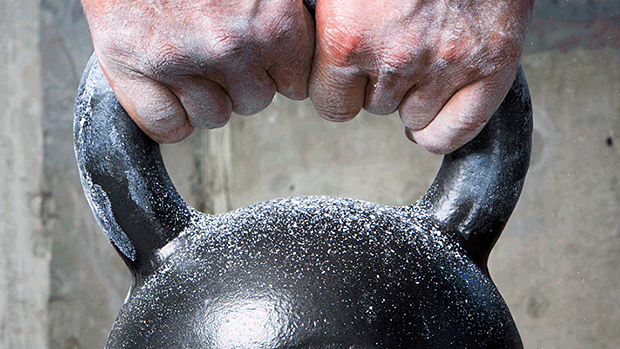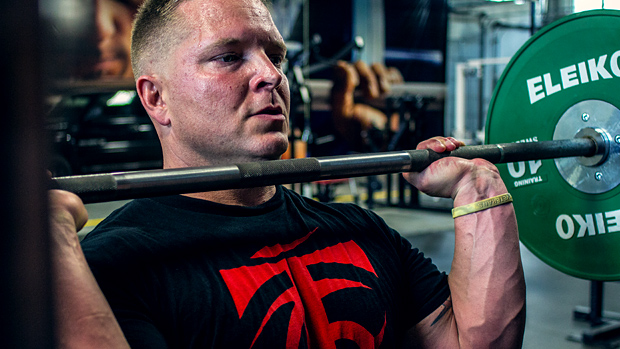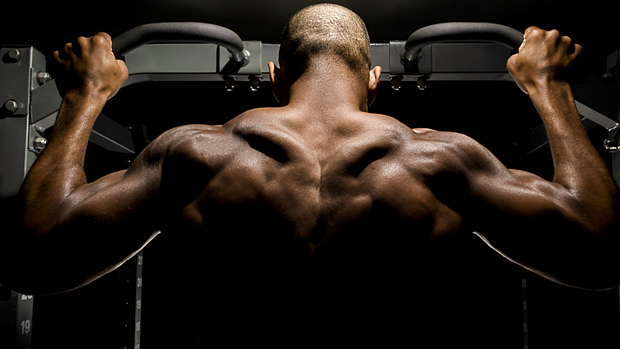Part 1 of this interview introduced us to Stuart McGill, one of the world's leading experts on all things spine related. While you might not have ever injured your back, wait a while. If you're a serious lifter and you're not employing spine-healthy techniques, the day will come when your back will insist that it get the respect it deserves.
When that day comes, you want Stuart McGill on your side.
But knowing good spine mechanics isn't only for avoiding a major league ouchie; it can also help you get the most out of your training programs.
Read on and learn what you've been doing wrong!
(When we left Marc and Stuart McGill last week, they were discussing the myth of the upper and lower rectus abdominus.)
T-Nation: You're saying that there's no way to work the lower-abs vs. the upper-abs, which is very contradictory to conventional wisdom. Can you expand on this?
SM: To be clear, I'm only talking about the rectus abdominus. There have been several problems in the scientific literature leading to misinterpretation. There's a muscle called pyramidalius, which is a lower muscle that overlays the bottom beads of rectus, but only in some people–it's an optional muscle.
Those using EMG (electromyography) who claim there is an upper and lower rectus might be monitoring pyramidalius, but if you control with calibrated and normalized EMG our work shows that all four beads of rectus pretty much fire together within the noise and randomness of the signal. On the other hand there are absolutely regional differences in the obliques. You need several types of challenges to train all of the neuromuscular compartments of the obliques.
T-Nation: You said you train athletes to breathe while isometrically contracting their abdominals in various exercises. Why do you do this?
SM: In real life tasks you don't exhale during the concentric exertion phase and inhale with the lowering eccentric phase. But this is often recommended by the personal trainers in gyms! Real life may mean posting up against Shaq in the NBA while the athlete is breathing hard or perhaps your mom needs to be prepared for just stepping off an unseen curb. So we have all kinds of tricks to teach different people stabilizing patterns in these muscles–while they're challenged while breathing and/or while they're pushing a weight up, lowering it, etc.
Generally you don't want to entrain breathing to the exertion BUT there's always an exception. Does it apply to a powerlifter? No. If you're going for a record lift and you hold your breath but then let it out, you're in big trouble. For Olympic lifts we would train or allow the athlete to sip the air (but with minimal air flow) during the standing-stabilization phase that follows the clean; this prepares the athlete to maximize the elastic contributions preceding the jerk. So it's all part of maximizing elastic recoil, potentiating muscle, ensuring sufficient stability within the spine–there is so much technique involved. For ultimate performance without injury the athlete has to get it all right.
But that's a whole different world from training a basketball or football player. I also find the taller the athlete, the more difficulty they have learning to breathe and keeping a stable spine after a back injury. The same muscles are used for both. The abdominals, quadratus, latissimus, and extensors are needed for spine stability, yet the abdominal wall is heavily recruited during heavy challenged breathing. In this way, healthy breathing mechanics are essential for a stable spine.
Generally, the training begins with challenged breathing while developing the patterns in the diaphragm to do the ventilation work so that full efficiency of the abdominals are directed towards stability, and transferring power from the arms and shoulders down to the ground with minimal energy losses through the trunk, keeping the line of drive within the dynamic base of support, etc. We would have to get into a specific situation to really discuss optimal abdominal integration.
T-Nation: You're saying I can be safe if I can maintain a neutral spine posture while bracing during the lifting movement?
SM: No, I'm not going to go there–the issue of safety is a relative one. We can discuss more safe vs. less safe, but then we are into the legal argument of nominal risk. I don't want to get into my expert legal witness routine now!
T-Nation: But in general, if I brace while doing things in the gym...
SM: Well, again I would have to see the exercises and understand your training or exercise goals and then examine you to pre-qualify you as a person who should even be training in a specific way; but generally, bracing with a neutral spine lessens the risk. Let's go over a few mechanisms of injury: herniated disks require repeated full-flexion; fracture of a vertebral endplate will occur if your lumbar spine is flexed at about 25-40% less load than if it is in a neutral posture. If you aren't at the end range of motion the ligaments aren't stretched, so you can't strain or tear them. In terms of stability, the lumbar spine will buckle with about 20 pounds of compressive load, so it needs the guide wire system provided by the muscles. So there you have four different spine-damaging mechanisms for which a neutral spine that is muscularly braced can lessen the risk of injury.
T-Nation: But that doesn't ensure that we won't get injured.
SM: That's right. I need to see so much more of the training and technique, things like speed, or are they balancing the bar properly? Those sorts of things. Then I need to understand personal attributes–their previous injury history, their joint mobility, their balance within muscle pairs and groups.
Their motor/motion patterns are critical–maybe they are not at the stage where I would qualify them to even be lifting a heavy bar–and this is not uncommon. Without appropriate motion/motor patterns the risk of injury is too high.
I can think of a recent case where the athlete prepared by laying on his back and pushing a weight up a sled with their legs–a form of leg press. I don't know why anyone would want to train this motor pattern in the first place, we get so much more for the same amount of training effort doing one-leg squats for example, and you're far better off from a performance point of view and much safer, too.
The trick is to wisely choose the most appropriate challenge with minimal risk of injury–but not zero risk. In fact, that is the philosophical difference between the way we train athletes and our approach to designing back rehab programs. Training has some risk, back rehab must cause no pain under our approaches or the technique is incorrect. Pain inhibits the development of optimal motor patterns.
T-Nation: What would you consider the most painful sight at the gym?
SM: The most painful sight I guess in the gym is watching egos create situations where the body gets damaged. When I walk into a gym where no one knows who I am...it may be a college football or basketball team training and I see terrible technique with far too much weight, I know that person is headed for injury. I may offer a suggestion and they say, "Well, who the hell are you?" I've learned to just walk away but it breaks my heart to see so much potential being stupidly destroyed. I hate arguments like what's the perfect arm curl–that's stupid–especially when you've got guys doing this in the NFL. And believe me, they do. Isolating the elbow may be relevant for bodybuilding, but it has no place in creating a strong man.
T-Nation: What about strength coaches and personal trainers, what kind of mistakes do you see them make that sends shivers up your spine?
SM: Most people come to see me because of the poor advice they're given from their strength and conditioning professional. So I don't see the success stories–only the failures. For example, many trainers try and rehab bad backs with strength routines. But if the motion/motor patterns are perturbed or poor, strength training without this foundation will ensure the athlete remains chronic. The proper motor/motion patterns need to be regrooved first, followed by some endurance development and then finally strength, power agility, etc.
Another thing we do is provocative testing to observe the mechanical motion, motor patterns and loads that cause pain and try to take that out of their training repertoire or their task or whatever else they have to do. This really contrasts those gurus who use "if you can't then you must" training approaches. We say if it causes pain there is a reason, and we deal with the underlying disorder first.
And I don't believe in the work hardening approach as a rule. There is a fine line between what builds someone up verses what tears them down. And if they are not progressing, something needs to be changed–it may even mean making the exercises less challenging. So I'm an arrogant son of a gun sometimes, but I have to admit that I'm not always right either!
T-Nation: You said that strength coaches may be exacerbating current injuries in athletes. Can you expound on this?
SM: They come from so many different philosophies, some come from a bodybuilding background, or powerlifting, or Olympic weightlifting, etc. Some are very cognizant of healthy motion/motor patterns and will work on technique longer before they start building strength, agility, and speed. Others just come from building speed–you can't just do that either.
You must address their motion/motor patterns first. There are some wonderful strength and conditioning coaches that understand the notion of motion and motor patterns that have been around for years, but they are not so common in North America. This awareness of motion and motor patterns has certainly been in the Soviet and Eastern European culture for a while. So it all depends on who the coach is and what the athletes are presented with, it depends on the sport, it depends on the athlete, it depends, it depends, it depends...
You see some trainers who are incredibly innovative people. There are also high profile trainers–many are quoted in this magazine–who don't do any research themselves but read and put things together in a way that's consumable. This is fine and we need people to do this. But it's just that sometimes they don't realize the consequences of some of the things they're advocating. Some of the things they recommend are not the wisest for many. Many don't have a very clear understanding of how the back works. But at the end of the day some are very wise, innovative, and clever.
T-Nation: You also talk about our increased risk in the morning hours after waking. Can you explain this?
SM: As you know, you're taller when you wake up in the morning than when you go to bed at night. This is because the discs are hydrophilic, that means they suck up water while you sleep and when there are no stresses present.
After rising, hydrostatic stresses of just walking around and using the muscles during the day compress your spine and the fluid is squeezed out, decreasing the anular tensions in the disc. So, when you wake up the extra height in the discs are analogous to a full water balloon ready to burst and if you bend, you build up much higher stresses in the disc. In fact, the stresses are three times higher than when you perform the same bend two or three hours later.
Now I'm not talking about getting up and going for a walk or perhaps a boxer going for a jog first thing in the morning. I'm talking about heavy bending exercises, like for example the good-morning exercise or doing sit-ups. Somehow people thought that this would be a good thing to do in the morning. It's the worst possible thing you could do for the back first thing in the morning. I personally have a more favorite morning exercise, it's what I like to call a "great-morning," but I don't think my wife would appreciate me talking about it! Full spine bending first thing in the morning is a great way to damage your back–an unwise thing to do.
T-Nation: But what if I've got 3 kids and work 50 hours a week and the only time I have to work out is in the morning about 45 minutes after waking?
SM: Having said all that Marc, never say never! For some people they'll never have a back problem. They're lucky. But if you have a bit of a ticklish back and you have to be careful with it, then be aware of what you're doing first thing in the morning.
Again, I can't give you a program that will work with everybody, I can't even give you instructions that will work with everybody or work with a team. Eevery athlete, every person is an individual. Some people can tolerate this first thing in the morning, but many bad backs who come to see me–and that's why they're coming–can't.
I have to test them to figure out what precisely is exacerbating their bad back and then remove that from their routines. If that happens to be not bending first thing in the morning, and that's a very common one, then that's what you have to do. Other people can take all kinds of abuse to their back but then it's their knees or shoulders you have to protect. But what's the number one injury that people are concerned with? It's their back.
T-Nation: I've read your new book, Low Back Disorders: Evidence-Based Prevention and Rehabilitation. Some of the issues you cover are rather complex–who would you say would benefit from your book?
SM: Well, it's interesting. Some lay people have read it and said it's rocked their world in terms of what they do with their personal routines. I've read a few of the reviews on Amazon's web site and one guy who's had a bad back for 30 years said it has changed his life. The book isn't for the average person. After all, who wants to be average?
People who have a fondness for mechanics and are adamant about understanding their body and are tired of people telling them the simple things that are almost insulting like, "When you lift, bend the knees and keep the back straight," will appreciate the book. Very rarely does this kind of advice actually help. So if you want to go above and beyond kindergarten level advice than you might be interested in the book. But certainly I wrote it for rehabilitation professionals. My next book is going to be on performance.
T-Nation: When do you expect that to be published?
SM: I can't say for sure but I have my next sabbatical in three years and hope to do it then at the very latest.
T-Nation: Considering the T-man, what would you say are the key points that we should consider when training to stay injury-free, strong, and looking good?
SM: Again, I need to know what type of training you're doing. If you're training for performance we're going to do some very interesting things. For example, when you look at some of the old Soviet lifters that were very successful, some of them never lifted competitive loads in training. They trained at very high rates of speed in a balanced environment with perfect technique. If that's where you want to head with this you may have to completely change your current paradigm. I need to know what the specific objectives of the individual are before I can answer your question.
When you examine the science, quite often you realize that a lot of what you hear is mythology. This is not simple stuff – so the top T-man will learn how the spine and the rest of the body works so they become their own best expert.
T-Nation: How about any general wisdom you would like to share with us?
SM: Never get married to a single philosophy. As soon as you know it all, shake your head because you are probably missing something.
The spine is a difficult beast. A lot of general principles don't carry over to the spine.
Listen to all kinds of different people, don't throw away all of the things you've learned over the years and follow one guru: there is no single fitness god! And if you find someone that says they've found all the answers, be wary. It's nice to hear the experts say they don't know.
Supremely important for the T-man is to listen to your own body. Again, there is a subtle difference between what is building people up, versus what is tearing them down. Work is good, but not too much and not too little either.
You know when I look at some of the Westside training philosophies with the use of labile weights, using chains and using elastics with their squat racks/routines, that's a whole new wonderfully innovative world. But then again some of the routines produce high reverse shear loads. Great for some, not so good for others. The T-man has to have an independent mind, an open mind, and the confidence to be a skeptic.
There's a time and place for virtually anything; again, it depends, it depends, it depends...
T-Nation: Thanks for spending the time to chat with us Stu.
SM: My pleasure Marc. Keep up the great work.




